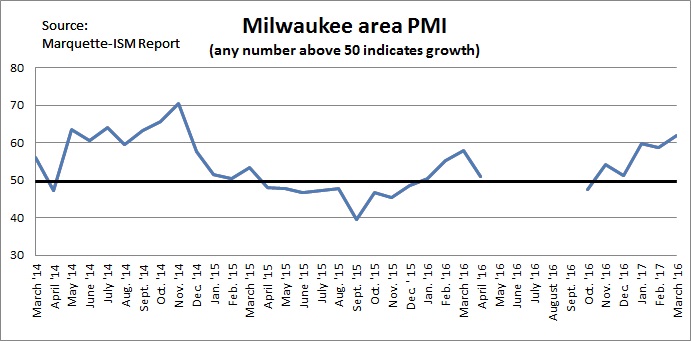After a slight decline in February, the Milwaukee-area PMI rose to 61.77 in March continuing a general upward trend in recent months and matching a National Association of Manufacturers survey that said optimism in the industry is at its highest level in 20 years.
The March reading was up from 58.69 in February and was the highest since November 2014. The report was discontinued for several months last year. Any reading above 50 indicates growth in the region’s manufacturing industry.
The Marquette-ISM Report on Business, which includes the PMI reading, included plenty of positive comments about business conditions, including optimistic customers and revenue to back it up. One respondent noted the mining and heavy equipment industries, which have been in a prolonged downturn, appeared to be seeing increased activity.
Doug Fisher, Marquette Center for Supply Chain Management director, said there seemed to be a “very solid underpinning of optimism.”
He noted all of the indices included in the report were trending toward increased activity.
“There’s a consistency in the numbers,” he said, suggesting businesses weren’t just hoping for an improved business climate from the new presidential administration.
There were also signs of challenges, which Fisher said is to be expected as activity increases. One respondent noted demand is very good for the next 90 days, but the forecast is limited after that. Others cited raw material issues and suppliers seeking to secure price increases.
Others pointed to potential labor issues and the hiring outlook for both blue and white collar workers increased. The diffusion index, which seeks to eliminate positive or negative bias, for blue collar work jumped from 52.5 to 65.3 while white collar was up from 50.2 to 55.4.
The general business outlook for the next six months was down slightly. The percentage expecting positive conditions was still at 50 percent, just as it was in February. The number expecting things to get worse, however, increased from 5 to 13.6 percent. The result was a diffusion index that dropped from 72.5 to 68.2 percent.
The National Association of Manufacturers first quarter outlook survey, meanwhile, found 93.3 percent of respondents were positive about their own company’s outlook, up from 77.8 percent in December. The result was similar for small, medium and large companies, with all three sizes above 90 percent.
The NAM survey found manufacturers expecting increased growth rates over the next 12 months for sales, 4.9 percent compared to 3 percent in December; production, 4.8 percent versus 3 percent; capital investments, 2.1 percent versus 1.3 percent; full-time employment 2.3 percent versus 1 percent; and wages, 2 percent versus 1.7 percent.
“The rising confidence stems from the belief that the new (Trump) administration in Washington, D.C. will bring much needed regulatory relief—as well as reforms to the tax code and a significant infrastructure package,” the NAM survey report said.
Read more economic reports at the BizTracker page.
